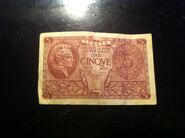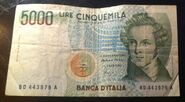m (→References) |
Tag: apiedit |
||
| Line 21: | Line 21: | ||
|mint=[[Istituto Poligrafico e Zecca dello Stato]] |
|mint=[[Istituto Poligrafico e Zecca dello Stato]] |
||
}} |
}} |
||
| − | The '''Italian lira''' ( |
+ | The '''Italian lira''' ({{wp|en|Italian language|Italian}}: ''Lira italiana''; [[Currency sign|sign]]: ₤; [[ISO 4217|code]]: {{code|'''ITL'''}}) was the [[currency]] of [[Italy]]. Until 1946, it was divided into 100 [[Centesimo|centesimi]]. It was adopted in 1862 and used until 2002, when it was replaced by the [[euro]]. |
==History== |
==History== |
||
Latest revision as of 23:48, 10 March 2016

|
This page uses Creative Commons Licensed content from Wikipedia (view authors). |
The Italian lira (Italian: Lira italiana; sign: ₤; code: ITL) was the currency of Italy. Until 1946, it was divided into 100 centesimi. It was adopted in 1862 and used until 2002, when it was replaced by the euro.
History[]
In 1861, coins were minted in Florence, Milan, Naples and Turin in denominations of 1, 2, 5, 10 and 50 centesimi, 1, 2, 5, 10 and 20 lire, with the lowest four in copper, the highest two in gold and the remainder in silver. In 1863, silver coins below 5 lire were debased from 90% to 83.5% and silver 20 centesimo coins were introduced. Minting switched to Rome in the 1870s.
In 1919, with a purchase power of the lira reduced to 1/5 of that of 1914, the production of all earlier coin types except for the nickel 20 centesimi halted, and smaller, copper 5 and 10 centesimi and nickel 50 centesimi coins were introduced, followed by nickel 1 and 2 lire pieces in 1922 and 1923, respectively. In 1926, silver 5 and 10 lire coins were introduced, equal in size and composition to the earlier 1 and 2 lire coins. Silver 20 lire coins were added in 1927.
In 1936, the last substantial issue of silver coins was made, whilst, in 1939, moves to reduce the cost of the coinage lead to copper being replaced by aluminium bronze and nickel by stainless steel. All issuance of coinage came to a halt in 1943.
In 1946 coin production was resumed, although only in 1948, with the purchasing power of the lira reduced to 2% of that of 1939, numbers minted exceed 1 million. To begin with, four denominations were issued in aluminium, 1, 2, 5 and 10 lire: these coins were in circulation together with the AM-lire and some of the old, devalued coins of the Italian Kingdom. In 1951, the government decided to replace all the circulating coins and bills with new smaller-sized 1, 2[15], 5 and 10 aluminium lire and in 1954–1955, Acmonital (stainless-steel) 50 and 100 lire coins were introduced, followed by aluminium-bronze 20 lire in 1957 and silver 500 lire in 1958. Increases in the silver bullion price led to the 500 lire coins being produced only in small numbers for collectors after 1967. The 500 lire (and later the 1000 lire) also appeared in a number of commemorative coin issues, such as the centennial of Italian unification in 1961.
In 1977, aluminium-bronze 200 lire coins were introduced, followed in 1982 by the bimetallic 500 lire. This was the first bi-metallic coin to be produced for circulation, minted using a system patented by IPZS. It was also the first to feature the value in braille[16].
Gallery[]
Related currencies[]
- Sammarinese lira
- Vatican lira
- Am-lira
- Tripolitanian lira
- Trieste lira
- Ljubljana lira
Exchange rates[]
| Current ITL exchange rates | |
|---|---|
| From Google Finance [1]: | AUD CAD CHF EUR GBP HKD JPY USD |
| From Yahoo! Finance [2]: | AUD CAD CHF EUR GBP HKD JPY USD |
| From OzForex [3]: | AUD CAD CHF EUR GBP HKD JPY USD |
| From XE.com [4]: | AUD CAD CHF EUR GBP HKD JPY USD |
| From OANDA.com [5]: | AUD CAD CHF EUR GBP HKD JPY USD |
Of the above, Xe.com and OANDA.com are the only sites that provide exchange rates for the lira.
| |
References[]
- ↑ Campione d'Italia is excluded.
- ↑ http://www.cilibertoribera.it/indexLIRA%20Storia%20e%20curiosit%C3%A0.htm
- ↑ http://www.worldwide-tax.com/italy/ita_infl.asp
- ↑ Dropped in 1924.
- ↑ Dropped in 1917.
- ↑ Dropped in 1943.
- ↑ Dropped in 1943.
- ↑ Dropped in 1903.
- ↑ Dropped in 1943.
- ↑ Dropped in 1959.
- ↑ Dropped in 1959.
- ↑ Dropped in 1957.
- ↑ Replaced by a bimetallic coin in 1982.
- ↑ Replaced by a bimetallic coin in 1997.
- ↑ The 2 lire coin was not minted in 1951 and 1952.
- ↑ Krause, Chester L., and Clifford Mishler (1991). Standard Catalog of World Coins: 1801–1991 (18th ed.). Krause Publications. ISBN 0873411501.
| Italian lira (1862-2002) | |
|---|---|
| Banknotes | 50 c. • ₤1 • ₤2 • ₤5 • ₤10 • ₤20 • ₤50 • ₤100 • ₤500 • ₤1000 • ₤2000 • ₤5000 • ₤10,000 • ₤20,000 • ₤50,000 • ₤100,000 • ₤500,000 |
| Coins | Official: 1 c. • 2 c. • 5 c. • 10 c. • 20 c. • 50 c. • ₤1 • ₤2 • ₤5 • ₤10 • ₤20 • ₤50 • ₤100 • ₤200 • ₤500 • ₤1000 |
| Miscellaneous | IPZS • Commemorative coin • Sammarinese lira • Vatican lira • Am-lira • Tripolitanian lira • Trieste lira • Ljubljana lira |
| Pre-euro currencies |
|---|


